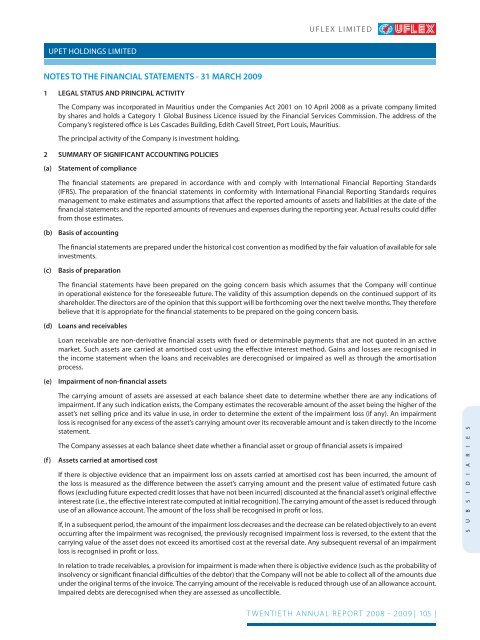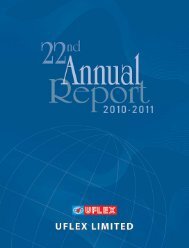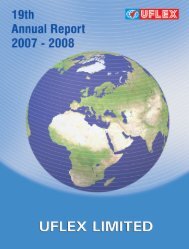Our endeavour is to enhance Stakeholders' Value - Uflex Ltd.
Our endeavour is to enhance Stakeholders' Value - Uflex Ltd.
Our endeavour is to enhance Stakeholders' Value - Uflex Ltd.
Create successful ePaper yourself
Turn your PDF publications into a flip-book with our unique Google optimized e-Paper software.
DIRECTOR’S UPET HOLDINGS REPORT LIMITED<br />
NOTES TO THE FINANCIAL STATEMENTS - 31 MARCH 2009<br />
1 LEGAL STATUS AND PRINCIPAL ACTIVITY<br />
UFLEX LIMITED<br />
The Company was incorporated in Mauritius under the Companies Act 2001 on 10 April 2008 as a private company limited<br />
by shares and holds a Category 1 Global Business Licence <strong>is</strong>sued by the Financial Services Comm<strong>is</strong>sion. The address of the<br />
Company’s reg<strong>is</strong>tered offi ce <strong>is</strong> Les Cascades Building, Edith Cavell Street, Port Lou<strong>is</strong>, Mauritius.<br />
The principal activity of the Company <strong>is</strong> investment holding.<br />
2 SUMMARY OF SIGNIFICANT ACCOUNTING POLICIES<br />
(a) Statement of compliance<br />
The fi nancial statements are prepared in accordance with and comply with International Financial Reporting Standards<br />
(IFRS). The preparation of the fi nancial statements in conformity with International Financial Reporting Standards requires<br />
management <strong>to</strong> make estimates and assumptions that aff ect the reported amounts of assets and liabilities at the date of the<br />
fi nancial statements and the reported amounts of revenues and expenses during the reporting year. Actual results could diff er<br />
from those estimates.<br />
(b) Bas<strong>is</strong> of accounting<br />
The fi nancial statements are prepared under the h<strong>is</strong><strong>to</strong>rical cost convention as modifi ed by the fair valuation of available for sale<br />
investments.<br />
(c) Bas<strong>is</strong> of preparation<br />
The fi nancial statements have been prepared on the going concern bas<strong>is</strong> which assumes that the Company will continue<br />
in operational ex<strong>is</strong>tence for the foreseeable future. The validity of th<strong>is</strong> assumption depends on the continued support of its<br />
shareholder. The direc<strong>to</strong>rs are of the opinion that th<strong>is</strong> support will be forthcoming over the next twelve months. They therefore<br />
believe that it <strong>is</strong> appropriate for the fi nancial statements <strong>to</strong> be prepared on the going concern bas<strong>is</strong>.<br />
(d) Loans and receivables<br />
Loan receivable are non-derivative fi nancial assets with fi xed or determinable payments that are not quoted in an active<br />
market. Such assets are carried at amort<strong>is</strong>ed cost using the eff ective interest method. Gains and losses are recogn<strong>is</strong>ed in<br />
the income statement when the loans and receivables are derecogn<strong>is</strong>ed or impaired as well as through the amort<strong>is</strong>ation<br />
process.<br />
(e) Impairment of non-fi nancial assets<br />
The carrying amount of assets are assessed at each balance sheet date <strong>to</strong> determine whether there are any indications of<br />
impairment. If any such indication ex<strong>is</strong>ts, the Company estimates the recoverable amount of the asset being the higher of the<br />
asset’s net selling price and its value in use, in order <strong>to</strong> determine the extent of the impairment loss (if any). An impairment<br />
loss <strong>is</strong> recogn<strong>is</strong>ed for any excess of the asset’s carrying amount over its recoverable amount and <strong>is</strong> taken directly <strong>to</strong> the income<br />
statement.<br />
The Company assesses at each balance sheet date whether a fi nancial asset or group of fi nancial assets <strong>is</strong> impaired<br />
(f) Assets carried at amort<strong>is</strong>ed cost<br />
If there <strong>is</strong> objective evidence that an impairment loss on assets carried at amort<strong>is</strong>ed cost has been incurred, the amount of<br />
the loss <strong>is</strong> measured as the diff erence between the asset’s carrying amount and the present value of estimated future cash<br />
fl ows (excluding future expected credit losses that have not been incurred) d<strong>is</strong>counted at the fi nancial asset’s original eff ective<br />
interest rate (i.e., the eff ective interest rate computed at initial recognition). The carrying amount of the asset <strong>is</strong> reduced through<br />
use of an allowance account. The amount of the loss shall be recogn<strong>is</strong>ed in profi t or loss.<br />
If, in a subsequent period, the amount of the impairment loss decreases and the decrease can be related objectively <strong>to</strong> an event<br />
occurring after the impairment was recogn<strong>is</strong>ed, the previously recogn<strong>is</strong>ed impairment loss <strong>is</strong> reversed, <strong>to</strong> the extent that the<br />
carrying value of the asset does not exceed its amort<strong>is</strong>ed cost at the reversal date. Any subsequent reversal of an impairment<br />
loss <strong>is</strong> recogn<strong>is</strong>ed in profi t or loss.<br />
In relation <strong>to</strong> trade receivables, a prov<strong>is</strong>ion for impairment <strong>is</strong> made when there <strong>is</strong> objective evidence (such as the probability of<br />
insolvency or signifi cant fi nancial diffi culties of the deb<strong>to</strong>r) that the Company will not be able <strong>to</strong> collect all of the amounts due<br />
under the original terms of the invoice. The carrying amount of the receivable <strong>is</strong> reduced through use of an allowance account.<br />
Impaired debts are derecogn<strong>is</strong>ed when they are assessed as uncollectible.<br />
TWENTIETH ANNUAL REPORT 2008 - 2009 | 105 |<br />
S U B S I D I A R I E S





